Currently the major inspiration for Sam’s work is the quirky creatures found in the sea – particularly coral gardens. Drawing and collaging is an important part of her research and artistic practice, but the main focus is in stitching sculptures with textiles and found objects. Discovering that she can ‘sculpt’ with stitched textiles was a pivotal moment; hard to explain intellectually: it just feels right.
The pieces are constructed with ordinary materials – often recycled. The tactile act of creating is very important and the pieces are informed by Sam’s drawing, but come together intuitively. Although the origin of the materials is not always obvious they are selected for their inherent qualities and need to hold their form as 3D objects without reliance on stiffeners or wiring which is not sympathetic to the texture and aesthetic of the piece.
Different methods used by Sam are illustrated below.
[nor_column_wrap][nor_columns count=”one-half column”]

Hand stitched cotton string painted with acrylic paint; felt, paper and plastic beads threaded on monofilament.
[/nor_columns]
[nor_columns count=”one-half column”]
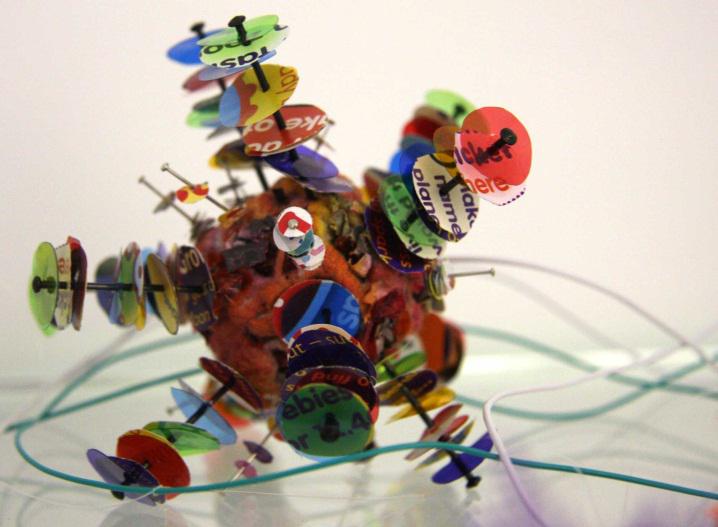
Hand stitched cotton string base over form of sweet wrappers painted with fabric dyes, papers and lighting gels and metal pins.
[/nor_columns]
[/nor_column_wrap]
The base of most of most of the sculptures is cotton string. Blanket stitch is used as it allows Sam to build a solid structure organically and to develop the shape flexibly as it grows. The simplicity of the stitch and the media provide contrast to elaborate embellishments. The base usually contains a small solid element – such as a washer, bottle top or wire which helps keep the shape – but apart from this the structure must balance on its own.
The embellishments use a range of techniques – led by the required aesthetic and media. Monofilament allows the fronds to maintain a shape and allow an organic shape controlled by the elements stitched together (as in Frank) whereas the pins used in Coral Ball provide a more dramatic, rigid look. The plastic used in Indie and Frank is carefully ripped imitate delicate fronds.
Indie and Frank have machine stitched tentacles using plain cottons which can be coloured. Their form can be maintained by not completely washing out the soluble support and drying them upside down. The rusted aesthetic of Indie has the side-effect of further stiffening the stitch – although it still feels like cloth more than metal.
[nor_column_wrap][nor_columns count=”one-half column”]
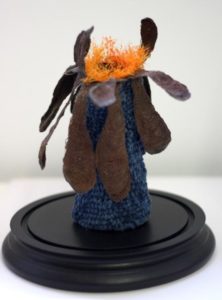
Hand stitched cotton string base dyed with indigo, machine stitched tentacles painted with rusted iron paint, plastic string bags
[/nor_columns]
[nor_columns count=”one-half column”]
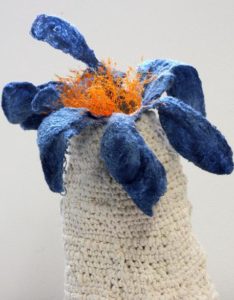
Hand stitched cotton string base, machine stitched tentacles dyed with indigo, plastic string bags
[/nor_columns]
[/nor_column_wrap]
Another method as yet not fully exploited by Sam is rusting and sculpting using shibori with screws. The cloth looks hard and fixed – but is soft silk to the touch. It is this contrast and contradiction of visual and textural elements which keeps Sam developing and experimenting with 3-D sculpting with stitched textiles.
[nor_column_wrap][nor_columns count=”one-half column”]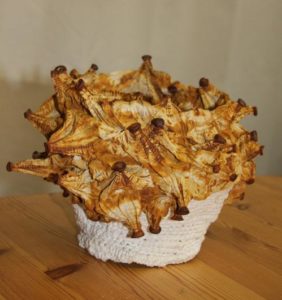
[/nor_columns]
[nor_columns count=”one-half column”]
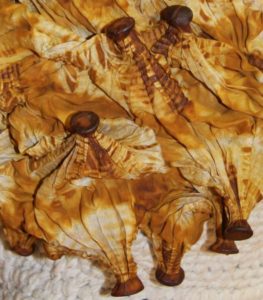
[/nor_columns]
[/nor_column_wrap]
Rusty Reef, 16x20cm
Hand stitched cotton string base with habotai silk rusted with screw-shibori
Written for June Barnes for the publication: C. June, Exploring Dimension in Quilt Art, 2012 Batsford
